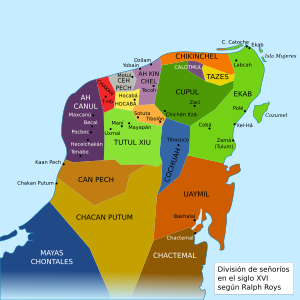Contents

Chakán (Mayan languages: Chakán, ‘1) oregano of this land; 2) macaw tail feathers.’)[2] is the name of one of the Mayan jurisdictions (kuchkabalob) that existed on the Yucatan Peninsula at the arrival of the Spanish conquistadors in the sixteenth century. Unlike other jurisdictions, Chakán did not seem to have a centralized government or control of a dominant Halach Uinik, as in the case of the provinces Ceh Pech or Ah Kin Chel. This is inferred from the fact that upon the Spaniards' arrival, Francisco de Montejo (el Mozo) was well received by some local leaders (batabob), but not others, such as Ah Kin Chuy, who organized resistance in the region's eastern towns to repel Spanish settlers.[3]
The most important city in the jurisdiction may have been Caucel, which controlled the region's salt trade since this material came from Chuburná and Sisal. Caucel's batab, named Ah Kin Euán, was so open to the Spanish from the outset of the conquest that he converted to Catholicism and changed his name to Francisco Euán, maintaining his position as batab for much longer.[3]
Mérida, the present day capital of Yucatan state, was founded on the ruins of Ti'Ho, a Mayan city that was virtually abandoned and had no recognizable leadership in the mid-16th century.
References
- ^ Roys, Ralph L. (Ralph Loveland), 1879-1965. (1957). The political geography of the Yucatan Maya. Carnegie Institution of Washington. OCLC 239893707.
{{cite book}}: CS1 maint: multiple names: authors list (link) CS1 maint: numeric names: authors list (link) - ^ Barrera Vásquez, Alfredo (1980). Diccionario Maya Cordemex: Maya - Español, Español - Maya. Mérida, Yucatán, México: Ediciones Cordemex.
- ^ a b Yucatán en el tiempo : enciclopedia alfabética. Duch, Juan. (1. ed.). Mérida, Yucatán, México: Inversiones Cares. 1998. ISBN 970-9071-00-9. OCLC 41674194.
{{cite book}}: CS1 maint: others (link)

